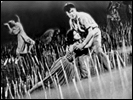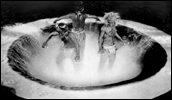Jigoku
- Year
- 1960
- Original title
- Jigoku
- Japanese title
- 地獄
- Alternative title
- Hell
- The Sinners of Hell
- Director
- Cast
- Running time
- 101 minutes
- Published
- 25 June 2001



by Jasper Sharp
Nobuo Nakagawa's early classic of Japanese horror, a karmic morality piece drawing upon Buddhist ideas of retribution and the afterlife, builds itself upon the doctrine that our earthly sins are to be atoned for after death, a principle shared by just about all of the world's religions. Culminating in a stunning evocation of the underworld, this epically ambitious project took seven months to produce and was partly funded from the director's own pocket.
Directly succeeding a stylish credit sequence designed to illustrate the temptations of mortal flesh by means of an unfolding montage of stills of scantily clad women, a foreboding voiceover sets out the film's philosophical basis against a backdrop of roaring tongues of fire and images from the films' apocalyptic climax. In the following scene these tenets are expanded on in a lecture entitled "Concepts of Hell" being given at a University theological department by Professor Yajima. One of the students, Shiro (Amachi), is listening particularly absorbedly to the description of the Japanese belief in The Eight Great Hells as contained in the Buddhist sutras.
The reasons for Shiro's attentiveness are twofold. Firstly, he's engaged to the professor's daughter, Yukiko, but more importantly, only the night before he was involved in a hit-and-run accident resulting in the death of a drunken mobster who stumbled in front of his car. Shiro himself was not at the wheel, this responsibility lying the sinister Tamura (Numata), a character who appears to represent the embodiment of the dark side of Shiro's conscience; a wicked alter ego who dissuades him from going to the police to confess their crime. Aside from the bond forged between them by their shared guilt, the relationship between the two is obscure. "Who is this guy Tamura? I know I don't like him", Shiro muses to himself.
When Shiro is involved in a car crash resulting in the death of Yukiko, he is dismissed from the house of his young fiancée's family. He seeks solace in the arms of the sassy harlot Yoko who, unbeknownst to him, is the lover of the dead yakuza. The next day, upon hearing the news that his mother is on her deathbed, he heads out to the country to the Tenjoen Senior Citizens Facility where he finds himself face-to-face with the demure Sachiko, a dead-ringer for the deceased girlfriend and daughter of a drink-sodden artist who lives next door working away at a portrait of hell. Meanwhile his father is spending his twilight years shacked up with a young girl from the city as his wife lies dying in the room next door.
As Shiro bides his time amongst the eccentric denizens of the Tenjoen, including a corrupt policeman and a negligent doctor, destiny seems very much to be catching up with him, firstly with the unexpected arrival of Tamura, and later in the appearance of the vengeful gangster's moll Yoko. Later, as the celebrations for the Tenjoen's tenth anniversary degenerate into a drunken orgy, Tamura reveals the past sins of all present, the clock freezes at 9pm, and the characters are all pitched headlong into hell to be judged.
Despite some startling image compositions (Shiro's encounter with Yoko on the bridge), the first hour of this extraordinary film unfolds relatively conventionally. However, after the eye-popping descent into the Abyss via a pit of flames, Shiro's subsequent voyage through the netherworld is ceaselessly spectacular. Alongside designer Haryasu Kurosawa, Nakagawa stunningly evokes a Dante-esque vision of hell using little more than dry ice and coloured spotlighting and the fruits of an extremely vivid imagination. From Shiro's convergence with Tamura on the banks of the River Sanzu that acts as the border between life and death, the narrative flows with a dreamlike fluidity through a succession of encounters that alternate between the grotesque and the tragically poetic.
A scene in which Shiro dangles upside down with a spike thrust gruesomely through his neck as he is judged by the Lord of the Eight Hells of Fire and Ice blurs into a reunion with his dead lover Yukiko. Lured on by the ghostly cry of their daughter Harumi, conceived days before Yukiko's death, he floats through a nightmarish landscape with sword blades protruding from the ground and inhabited by chanting procession of corpses, by turns haunted with visions of carnality and the burning symbol of the Buddhist Wheel of Life.
Produced at a time when, on an international level, the horror movie was undergoing a complete renaissance, this stunning evocation of the concept of the underworld is poles apart from the sort of films being put out by the genre's other main practitioners in the West at the time. Considering the shock with which Peeping Tom (Michael Powell, GB 1960), Psycho (Alfred Hitchcock, US 1960), Eyes Without a Face (Georges Franju, France 1959), and Stranglers of Bombay (Terence Fisher, GB 1959) were all greeted, it is intriguing to imagine how contemporary audiences would have reacted to this morbid parade of hell's infernal torments. Even by today's standards Jigoku is pretty graphic, the phantasmagoric imagery here on display is more akin to portrayals of the Final Judgement from the medieval Flemish artist Hieronymous Bosch by way of Benjamin Christensen's silent classic Häxan (1921), and anticipates the more nightmarishly sadistic work of the Brazilian José Mojica Marins (Tonight I Will Turn Your Corpse Red / Este Noite Encarnarei No Teu Cadaver, 1966 et al.) as skulls are crushed by giant, club-wielding ogres, and bodies are flayed, decapitated, and sawn in two. Shocking stuff indeed.
Alongside the less accomplished Morihei Magatani (whose films include The Blood Sword of the 99th Virgin / Kyuju-Kyuhonme no Kimusume, and Girl Divers From Spook Mountain / Ama no Bakamono Yashiki, both 1959), working under the aegis of the Shintoho production company allowed Nobuo Nakagawa to forge a reputation as the earliest and most accomplished director of the horror genre. Shintoho was formed by a number of prominent stars and directors who left Toho after a series of strikes at the larger company in 1947 (Shintoho means literally "New Toho"). Though at the peak of their production around 1957 they were making over 60 films a year, despite the lofty artistic ambitions of its founders and a number of prominent productions now considered to be classics (including Akira Kurosawa's Stray Dog / Nora Inu, 1948, and Kenji Mizoguchi's The Life of Oharu / Saikaku Ichidai Onna, 1952), financial problems were already begin to dog the studio and towards the late 50s it turned its hand towards more populist fare, including horror and war movies, attempting to grab the public's attention by slowly pushing up the levels of sex and violence contained in their product whilst reducing their running times and production costs.
Nakagawa's early kaidan (ghost) films, including The Ghost of Kasane Swamp (Kaidan Kasanegafuchi, 1957), Black Cat Mansion (Borei Kaibyo Yashiki, 1958), and The Ghost of Yotsuya (Tokaido Yotsuya Kaidan, 1959), drew upon a long tradition of folklore and legend, though titles such as Vampire Moth (Kyuketsuki Ga, 1956) and Lady Vampire (Onna Kyuketsuki, 1959) also added fantastical motifs inspired by foreign genre pictures. Many of these pictures starred Jigoku's main protagonist, the elfin Amachi, who later turned up in The Beast and the Magic Sword (El Bestia y la Espade Mágica, 1983), a Japanese co-production with Spanish horror icon Paul Naschy. In 1960 the studio crashed (though the name Shintoho was subsequently bought up, the new company scraping along throughout the 60s making cheap pinku movies, still existing in this form today), leaving Jigoku in distribution limbo until it was picked up by Toei several years later.
In its native land Nakagawa's Jigoku has been the subject of two remakes: in 1979 by Tatsumi Kumashiro, and a more recent release in 1999 from Joys of Torture maverick Teruo Ishii. Forty years later, this seminal work in world fantasy cinema still has the power to both shock and strike awe into the hearts of its viewers, and deserves to be brought to as wide an audience as possible.